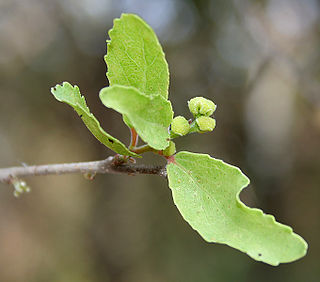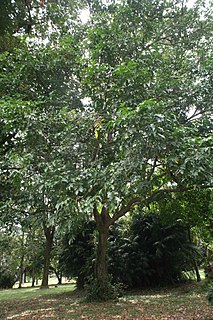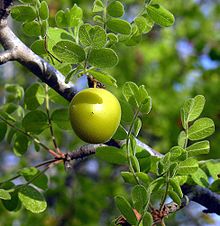
The Anacardiaceae, commonly known as the cashew family or sumac family, are a family of flowering plants, including about 83 genera with about 860 known species. Members of the Anacardiaceae bear fruits that are drupes and in some cases produce urushiol, an irritant. The Anacardiaceae include numerous genera, several of which are economically important, notably cashew, mango, poison ivy, sumac, smoke tree, marula, yellow mombin, Peruvian pepper and cuachalalate. The genus Pistacia is now included, but was previously placed in its own family, the Pistaciaceae.

Anacardium, the cashews, are a genus of flowering plants in the family Anacardiaceae, native to tropical regions of the Americas.

Buddleja is a genus comprising over 140 species of flowering plants endemic to Asia, Africa, and the Americas. The generic name bestowed by Linnaeus posthumously honoured the Reverend Adam Buddle (1662–1715), an English botanist and rector, at the suggestion of Dr. William Houstoun. Houstoun sent the first plants to become known to science as buddleja to England from the Caribbean about 15 years after Buddle's death.

Cercocarpus, commonly known as mountain mahogany, is a small genus of at least nine species of nitrogen-fixing flowering plants in the rose family, Rosaceae. They are native to the western United States and northern Mexico, where they grow in chaparral and semidesert habitats and climates, often at high altitudes. Several are found in the California chaparral and woodlands ecoregion.

Flacourtia is a genus of flowering plants in the willow family, Salicaceae. It was previously placed in the now defunct family Flacourtiaceae. The generic name honors Étienne de Flacourt (1607–1660), a governor of Madagascar. It contains 15 species of shrubs and small trees that are native to the African and Asian tropics and subtropics. Several species, especially F. indica, are cultivated as ornamentals and for their fruits. The trunks of small trees are often guarded by branching spines.

Drimycarpus is a small genus of trees in the cashew and sumac family Anacardiaceae. The generic name is from the Greek meaning "pungent fruit".

Amphipterygium is a small genus in the subfamily Anacardioideae of the cashew and sumac family Anacardiaceae.
Dobinea is a small genus of plants in the subfamily Anacardioideae of the cashew and sumac family Anacardiaceae. The species are dioecious and grow as shrubs or perennial herbs. They grow naturally in the East Himalaya region and China.
Fegimanra is a small genus of trees in the subfamily Anacardioideae of the cashew and sumac family Anacardiaceae. They grow naturally in west and west-central tropical Africa.

Holigarna is a genus of trees in the subfamily Anacardioideae of the cashew and sumac family Anacardiaceae. They grow naturally in India, Bangladesh and Indo-China. This is a poisonous tree if contacted it would irritate skin chemically and result in irreversible skin damage. Smoke from burning this wood is dangerously disabling.
Pseudosmodingium is a genus of plants in the subfamily Anacardioideae of the cashew and sumac family Anacardiaceae.
Bonetiella is a monotypic genus of shrubs in the subfamily Anacardioideae of the cashew and sumac family Anacardiaceae. It contains the single species Bonetiella anomala, which is endemic to northern and central Mexico.
Campylopetalum is a monotypic genus of shrubs in the subfamily Anacardioideae of the cashew and sumac family Anacardiaceae. It contains the single species Campylopetalum siamense, which is endemic to northern Thailand.
Cardenasiodendron is a monotypic genus of dioecious trees in the subfamily Anacardioideae of the cashew and sumac family Anacardiaceae. It contains the single species Cardenasiodendron brachypterum, which is endemic to Bolivia.
Faguetia is a monotypic genus of trees in the subfamily Anacardioideae of the cashew and sumac family Anacardiaceae. It contains the single species Faguetia falcata, which is endemic to eastern Madagascar.
Laurophyllus is a monotypic genus of dioecious shrubs in the subfamily Anacardioideae of the cashew and sumac family Anacardiaceae. It contains the single species Laurophyllus capensis, which is endemic to the Eastern Cape province of South Africa. The species is found on wooded hillsides and by streams.
Mosquitoxylum is a monotypic genus of trees in the subfamily Anacardioideae of the cashew and sumac family Anacardiaceae. It contains the single species Mosquitoxylum jamaicense, which grows naturally from southern Mexico to Ecuador and also in Jamaica.
Orthopterygium is a monotypic genus of dioecious plants in the subfamily Anacardioideae of the cashew and sumac family Anacardiaceae. It contains the single species Orthopterygium huaucui, which is endemic to western Peru.
Pegia is a genus of plants in the subfamily Spondiadoideae of the cashew and sumac family Anacardiaceae.

Pseudospondias is a genus of plants in the subfamily Spondiadoideae of the cashew and sumac family Anacardiaceae. They grow as dioecious shrubs or trees and are found in forests of Sub-Saharan Africa.









